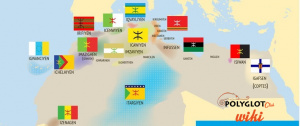Language/Kabyle/Grammar/Basic-sentence-structure
In this lesson, we will explore the basic sentence structure in Kabyle, a Berber language spoken predominantly in the northeastern region of Algeria. By understanding the basic sentence components and their order, you will be able to form simple sentences and have a solid foundation to build upon as you progress through the "Complete 0 to A1 Kabyle Course."
As a language teacher with 20 years of experience in teaching Kabyle, I will be sharing cultural information and interesting facts along the way to make your learning journey more engaging and enjoyable.
Kabyle sentence structure
Kabyle, like many other Berber languages, has a Subject-Verb-Object (SVO) sentence structure. This is similar to the sentence structure in English. In general, a Kabyle sentence is constructed with the subject first, followed by the verb, and finally, the object.
However, Kabyle also exhibits flexibility in its sentence structure. Depending on the context or the speaker's emphasis, the order of the sentence components may change. It is not uncommon for the verb to come first or for the object to precede the verb. Nevertheless, mastering the basic SVO structure will provide you with a strong foundation for constructing simple sentences in Kabyle.
Let's take a look at some examples showing the basic Kabyle sentence structure:
Examples:
| Kabyle | Pronunciation | English |
|---|---|---|
| Yiwen | /jĭwen/ | (A) man |
| Agadir | /aɣădĭr/ | (A) city |
| Yenna-yas | /Jenna-Ijas/ | He said to him |
In these examples, we can notice that the subject ("Yiwen" – a man) comes first, followed by the verb ("Yenna-yas" – he said to him) and finally, the object ("Agadir" – a city).
Simple sentences
To start forming simple sentences in Kabyle, it's important to become familiar with basic verbs, nouns, and pronouns. As we progress through the course, you will learn more about these different parts of speech and how they function in Kabyle sentences. For now, let's explore some simple sentences using basic verbs and nouns.
Examples:
| Kabyle | Pronunciation | English |
|---|---|---|
| Agerzam | /aɣɛrzăm/ | (A) lion |
| Yekči | /jəkčĭ/ | (He) eats |
| Amcan | /ămkăn/ | (A) sheep |
As you can see, the sentences follow the basic SVO structure. The subject ("Agerzam" – a lion) comes first, followed by the verb ("Yekči" – he eats) and finally, the object ("Amcan" – a sheep).
To make learning more enjoyable, we can explore some cultural information related to our examples. Kabyle culture is deeply rooted in its agricultural and pastoral traditions. Animals, such as sheep, have significant cultural and economic importance in Kabyle society.
Cultural fact: Amazigh poetry
In Kabyle culture, poetry is an essential aspect of the region's rich cultural heritage. Amazigh poetry, known as "Tamdyazt," often reflects the values and lifestyle of the Kabyle people. The themes of love, nature, social issues, and history are frequently featured in Kabyle poetry. Moreover, the poetic language is often characterized by its strong imagery and symbolism, highlighting the beauty and complexity of the Kabyle language.
Conclusion
In this lesson, we've covered the basic sentence structure in Kabyle, focusing on the Subject-Verb-Object order. We also explored some basic sentences using fundamental verbs and nouns. As you continue with the "Complete 0 to A1 Kabyle Course," you will learn more about the different parts of speech, verb conjugations, and other essential aspects of the Kabyle language.
Now that you have an understanding of the basic sentence structure in Kabyle, you will find it easier to create simple sentences and communicate with native speakers. Remember to practice regularly and immerse yourself in the language to reinforce your learning.
In the next lesson of the "Complete 0 to A1 Kabyle Course," we will delve into common greetings and farewells in Kabyle, preparing you for real-life interactions and conversations with native speakers. Stay tuned!

